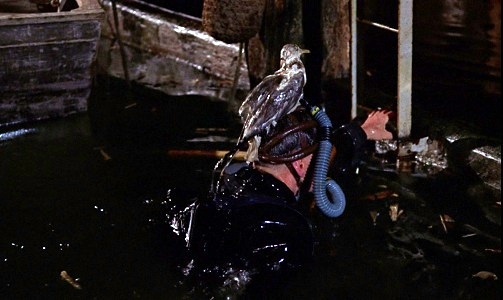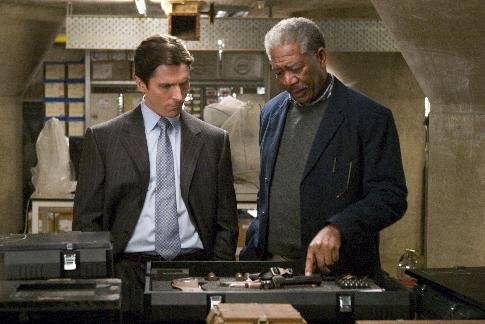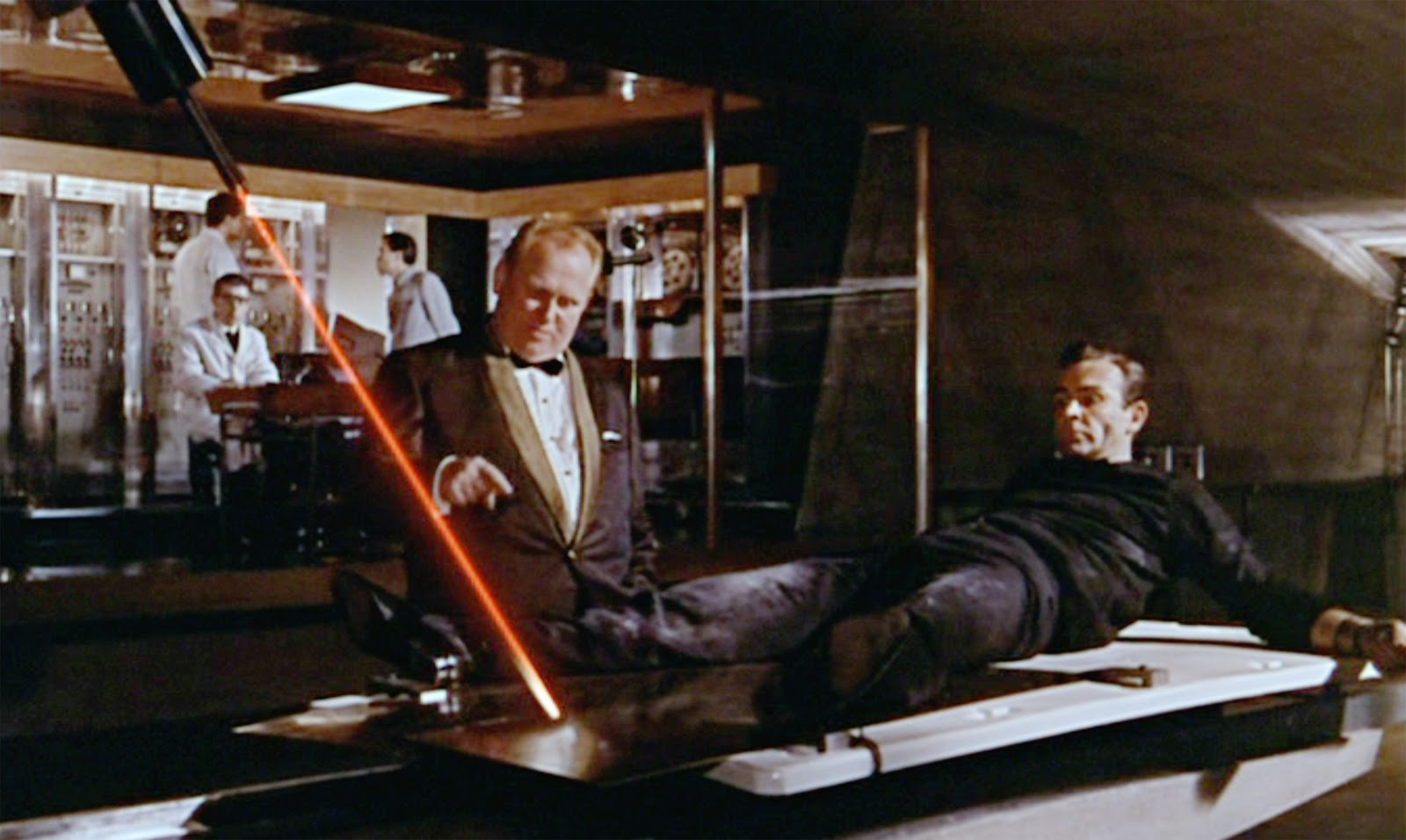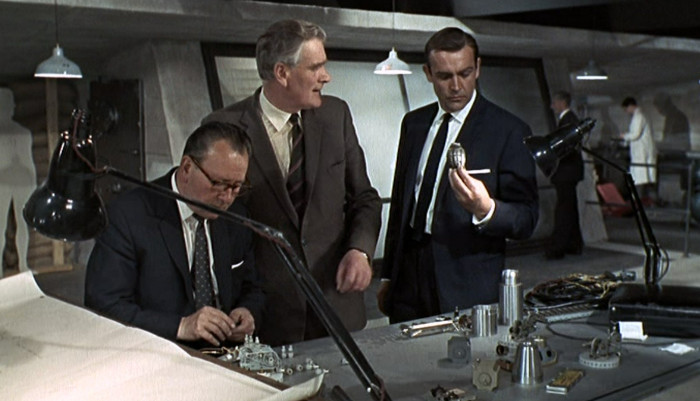When Q (Desmond Llewelyn) tells James Bond (Sean Connery) about his new car being equipped with an ejector seat, Bond is incredulous. “Ejector sh-eat! You’re joking!” Q isn’t, and 1964’s Goldfinger wasn’t messing around either. The first Bond blockbuster, released 50 years ago this week, was when the whole 007 jamboree permanently became a series of pseudo sci-fi flicks.
Though the third James Bond film released, Goldfinger is the one that brought on an obsession with espionage thrillers that cinema has not given up since. For a science fiction fan—or at least someone who enjoys fictional applications of possible technologies—Goldfinger is the grandpapa of a lot of gadget-heavy films, with the recent Christopher Nolan’s Dark Knight trilogy predominantly coming to mind. And while Bond films previous to Goldfinger featured a few pieces of technology, it was never the Sky Mall catalogue of outrageous spy-stuff like this movie became. To put it in perspective: From Russia to Love (1963) had a suitcase with some hidden compartments. Goldfinger (1964) has a car with machine guns, oil slick spewer, bullet-proof shields, a thingy for messing up someone’s tires like you’re Speed Racer, and, as mentioned, an ejector seat. Take that, trick suitcase.

Bond’s tech starts out decidedly low in this film, with his very first “gadget” being a fake seagull on his head. That’s right, the supposed coolest and most famous Bond film of them all begins with double-oh seven paddling around underwater, with his head disguised by wearing a fake bird on top of it. This sequence doesn’t last for long, and soon it transitions into the now infamous tuxedo-underneath-a-wetsuit-situation. But, later, when Bond is actually on the tail of illegal gold-launderer and all-around jerk Goldfinger, it’s time for Bond to get issued all his proper gadgets, including the infamous Aston-Martin DB5.
Though James Bond will drive some other cars throughout the years and some of them will be able to do more than have an ejector seat, be able to drive underwater, etc., none will be as iconic. Every time a James Bond movie wants to remind you that it’s a James Bond movie, he’ll be driving this car. At the beginning of GoldenEye (arguably a kind of reboot for the Bond franchise in 1995) Pierce Brosnan’s Bond drives an Aston-Martin in the film’s opening playful car chase. In both Casino Royale (2006) and Skyfall (2012), Daniel Craig’s Bond drives the same car, and in the latter film, its intoned that this is totally the same car as Craig jokingly threatens to eject Judi Dench, to which she replies “go ahead, eject me, see if I care.” (If you want a wacky theory as to how this might literally be the same car, check this out.)
Another icon that Goldfinger introduces isn’t actually a thing so much as a type of scene. When Q—Bond’s master of gadgets— shows 007 all the cool stuff he gets to cart around, the franchise ended up establishing a type of scene that played out over and over through the series of films, and can be found in other spy and heist movies. Batman Begins has the exact same scene between Bruce and Lucius Fox when they’re constructing the Batsuit and related vehicles and gear.

What about the bad guys? Well, James Bond may have had nifty electronic trackers that you put on people’s cars and the cool car itself, but the bad guys in Goldfinger have sci-fi inventions, too. In a super iconic scene, Goldfinger nearly cuts James Bond in half with an “industrial laser,” while Bond is tied to a bed (or something) of pure gold. This is a change from the novel in which Bond is strapped to a regular wooden table, and Goldfinger has a buzzsaw running up it. See! The book isn’t always better, particularly when lasers are involved. Plus, the whole cliché of super villains having lasers starts right here, and if this secret agent lives in a world of lasers, then saying he isn’t in a science fiction movie seems almost blasphemous.
Goldfinger’s scheme to use radiation to make the gold supply of Fort Knox worthless is also a little bit sci-fi, insofar as it requires a totally fictional (and outrageous) application of real science in order to pull off a high-tech heist. Now, though Goldfinger misunderstands the economy a little bit, and seems to have some other basic cognitive problems, it’s notable that this James Bond movie doesn’t end with a mad genius who is pointing a death ray at the entire world, as many, many other James Bond films do. In fact, when James Bond goes full sci-fi in Moonraker, the obliteration of everyone on Earth is exactly what’s at stake and lasers are everywhere.

But Goldfinger is a way more serious sci-fi movie than Moonraker, insofar as any James Bond movie can be called a “serious” anything. It tries a little harder than some of the films that follow it. In 1964 lasers were still novel, and the scheme of using radiation on gold seems more clever and complicated than several subsequent Bond-baddie plans. Plus, because the Aston-Martin is a real car, and everything about the car chase is realistic, it’s exciting. The Bond films would temporarily forget how to do this, and un-ironically or not gave James Bond an invisible car in 2002’s Die Another Day. I’ll say it again: the cool car that he drives is something we can’t actually see.
For now though, if you want to have a vodka martini, shaken, stirred, or even without any vodka, watching Goldfinger on its 50th birthday is a quick and easy way to see where science fiction started sneaking into spy films. And where spy films started sneaking into science fiction films.
Ryan Britt is a longtime contributor to Tor.com.











That scene in Batman Begins was SO reminiscent of James Bond, yeah.
It’s worth noting that Goldfinger’s plot in the movie is a direct response to the problems that make his plot in the book unworkable.
All this is irrelevant. Everybody knows that FRWL was the best of the franchise
It would’ve been hard for there to be a laser in the novel, since the acronym LASER wasn’t coined until the same year the book was published (so probably after the manuscript was written), and the first functioning one wasn’t built until a year later.
I notice that in listing the car’s gadgets, you didn’t mention the GPS tracking system (i.e. the scrolling maps pinpointing Bond’s and Goldfinger’s locations). Remember that in 1964 that was total sci-fi.
@5: Actually, ground-based radio navigation systems had been in use since WWII. They were generally based on radar and transponders. Presumably the car’s tracker in the movie was meant to be based on a radar system of that sort rather than satellite navigation — although the first prototype of a satellite navigation system like the later GPS was tested by the US Navy in 1960.
I have a James Bond anecdote that relates to this post. I had a summer job in Boca Raton, Florida in the late 90s. If you don’t know, Boca is an incredibly wealthy town–very expensive to live in this plush area. My anecdote will make this point.
While I was working there, a local storage unit had been broken into and guess what was stolen? One of the original James Bond Aston Martin cars from the Goldfinger film (shown at the top of this post). Some guy in Boca Raton had actually owned it (and then lost it) at the time!
I’m (re)watching every James Bond movie, in production order, this year (http://randomalex.net/tag/project-bond/). It’s been fascinating to see the waxing and waning of what I would regard as overt SF elements – things that are integral to the plot – and covert elements, like the ejector seat, that are almost window dressing to make an awesome film. Bond has had to deal with a lot of space lasers in his time, poor fella. And his gadgets have veered between outrageous tech – as suggested here – and more humdrum stuff… sometimes just because of the reality of when it’s made.
Bah. Everything in the Bond movies was stolen from Johnny English. He showed the real reason for Aston Martin’s having ejector seats …
What Goldfinger the film created was the genre now called spy-fi. But it was other franchises that really established the amazing gadgets vs scientific tyranny motif, most notably of course The Man from U.N.C.L.E., Mission: Impossible, The Avengers and so on. Mainly a child of the ’60s the genre may be making a comeback with Agents of S.H.I.E.L.D.. Personally I hope so as I have great fondness for it despite the deeply regrettably Moore Bonds The Spy Who Loved Me and Moonraker which pretty much killed the young genre as firmly as a cyanide coated miniaturised missile fired from the eye of a teddy bear.
The Bond films would temporarily forget how to do this, and un-ironically or not gave James Bond an invisible car in 2002’s Die Another Day. I’ll say it again: the cool car that he drives is something we can’t actually see.
That movie totally had a visible car chase.
And improvised parasurfing. Never forget.
@11 and Halle Berry in a bikini with a knife strapped to it. So many reactions to that scene . . . I don’t even . . .
@6: Most likely correct. In the novel (wait … there’s a BOOK? Heavens!) the Homer was strictly an audio device that, according to its pitch, told Bond his distance from the transmitter on Goldfinger’s Rolls. Bond had to backtrack a few times to keep close to his quarry. OK for text, but the sequence lacked a certain visual panache that would have been useful on a big screen.
Let’s not forget that in Dr. No, the villain with mechanical hands is using a nuclear-reactor-powered radio transmitter to interfere with Mercury space capsule launches. Science fiction has been part of this franchise from film one.
And Bond would come back to outer space stuff time and time again, even those times when Bond didn’t end up going into space. Something like one out of three Bond movies had some kind of connection to outer space.